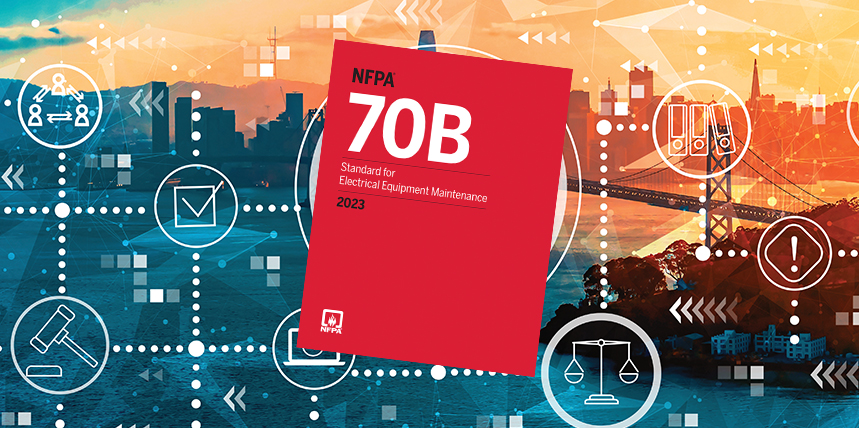In January 2023, NFPA 70B transitioned from the Recommended Practice for Electrical Equipment Maintenance to the Standard for Electrical Equipment Maintenance. The change became effective on January 16, 2023, when it was approved as an American National Standard by the American National Standards Institute (ANSI).
As NFPA 70B moves from a recommended practice to an enforceable standard, now is the time to update or create the electrical maintenance plan (EMP) to ensure your customer’s facility is compliant. The intent of this article is to focus on the administrative requirements of NFPA 70B, as outlined in Chapter 1 through Chapter 6.
CHAPTER 1
Chapter 1 defines the scope of NFPA 70B, which covers the preventive maintenance of electrical, electronic, and communication systems and equipment. The standard is to provide for the practical safeguarding of persons, property, and processes from the risks associated with failure, breakdown, or malfunction and a means to establish a condition of maintenance of electrical equipment and systems for safety and reliability.
Condition of Maintenance. The State of the electrical equipment considering the manufacturers’ instructions, manufacturers’ recommendations and applicable industry codes, standards, and recommended practices. [70E, 2021].
While the term is defined in NFPA 70E, establishing a condition of maintenanceis essential in being able to accomplish the requirements outlined within the pages of the document to help keep workers safe. NFPA 70E requires employers to implement and document an electrical safety program (ESP) that directs activity appropriate to the risk associated with electrical hazards. The ESP is required to include elements that consider the condition of maintenance of electrical equipment and systems. Electrical equipment that has not been maintained properly or is not functioning properly poses a significant additional risk to those who are working on that equipment and its associated systems.
The application of NFPA 70B applies to electrical, electronic, and communications systems and equipment typically installed in industrial plants, institutional and commercial buildings, and large multifamily residential complexes. It is not intended to duplicate or replace instructions provided by manufacturers. Consumer appliances and equipment intended primarily for use in the home are not within scope. The standard is not intended to prevent equivalent or superior systems, methods, or devices with more quality, effectiveness, and safety than those in the standard. The standard does not apply to single-family homes or small apartment buildings.
CHAPTER 2
Chapter 2 contains the referenced publications of the standard: Merriam-Webster’s Collegiate Dictionary, 11th edition; NFPA 70–2023, National Electrical Code; and NFPA 70E–2021, Standard for Electrical Safety in the Workplace.
CHAPTER 3
Chapter 3 includes the definitions that shall apply to the terms used in this standard. Below are two important definitions within Chapter 3.
Shall. Indicates a mandatory requirement.
Standard. An NFPA standard, the main text of which contains only mandatory provisions using the word “shall” to indicate requirements and that is in a form generally suitable for mandatory reference by another standard or code or for adoption into law. Nonmandatory provisions are development activities, not to be considered a part of the requirements of a standard and shall be located in an appendix. Annex, footnote, information note, or other means as permitted in the NFPA manuals of style. When used in a generic sense, such as in the phrases “standards development process” or “standard development activities,” the term “standard” includes all NFPA standards, including codes, standards, recommended practices, and guides.
CHAPTER 4
Chapter 4 addresses general requirements by specifically stating that electrical equipment shall be maintained using the manufacturer’s instructions, as well as applicable codes and standards. The industry consensus standards are identified as a replacement for the manufacturer’s instructions when those manufacturer instructions are not available.
Section 4.2.1 states: “The equipment owner shall implement and document an overall EMP that directs activity appropriate to the safety and operational risks.”
This lays out the requirements, creation, documentation, and implementation of an EMP. That program shall be appropriate for the safety and operational risks of the facility.
Electrical Maintenance Program (EMP). A managed program of inspecting, testing, monitoring, analyzing, and servicing electrical systems and equipment with the purpose of maintaining safe operations and production by reducing or eliminating system interruptions and equipment failures.
Chapter 4 provides new details and requirements for the development and execution of an EMP. Creating or updating your electrical maintenance program as outlined in 4.2 is critical to meeting the requirements to ensure the facility is compliant.
The EMP must be documented and needs to identify the principles upon which it is based and the goals to be achieved and shall be designed to function in conjunction with the applicable electrical safety program.
The EMP shall include the following elements:
- An electrical safety program that addresses the condition of maintenance
- Identification of personnel responsible for implementing each element of the program
- Survey and analysis of electrical equipment and systems to determine maintenance requirements and priorities
- Developed and documented maintenance procedures for equipment
- A plan of inspections, servicing, and suitable testing
- A maintenance, equipment, and personnel documentation and records-retention policy
- A process to prescribe, implement, and document corrective measures based on collected data
- A process for incorporating design for maintainability in electrical installations
- A program review and revision process that considers failures and findings for continuous improvement
The EMP shall identify the controls by which it is measured and monitored and shall include a method to utilize all associated reports for feedback and refinement including the following:
- Electrical safety incidents
- Equipment malfunctions
- Unintended operations or alarms
- Operation of protective devices
NFPA 70B requires the EMP to be audited and reviewed at least once every five years and an EMP coordinator shall be identified.
EMP Coordinator. The individual responsible for coordinating the implementation and operation of the EMP.
The EMP coordinator shall determine the scope of work to be performed and develop a prioritized plan for the electrical maintenance of the electrical equipment or systems. The electrical equipment and systems shall be evaluated to determine the appropriate scope and frequency of maintenance. The environmental, physical, or operating conditions of a specific installation shall be considered in determining the frequency of electrical maintenance.
The EMP coordinator is to perform planned inspections, the following considerations shall be reviewed during the development of planned inspections:
- Potential of equipment failure to endanger or threaten personnel safety
- Manufacturer’s recommended services and maintenance practices and procedures
- Operational environment
- Operating load conditions and equipment rating
- Failure and repair of equipment causing extensive downtime and lost production dollars
- Equipment condition.
- Production and operating schedules
- Failure history
- Inspection history
The document requires maintenance personnel to be qualified and trained and for the employer to appropriately determine and document that qualification and training. Records of that training shall be retained for the duration of the person’s employment.
Qualified Person. One who has demonstrated skills and knowledge related to the construction and operation of electrical equipment and installations and has received safety training to identify the hazards and reduce the associated risks.
A copy of the acceptance test reports, if available, shall be included in the maintenance records.
Additions, rework, and retrofitting of equipment are also specifically addressed in this chapter. The text identifies that safety certification for repair or rebuilt equipment shall be kept and that any such work should not impair the expected performance or safety of the equipment. The text also states that refurbished or remanufactured equipment shall be marked as such.
CHAPTER 5
Chapter 5 focuses on general safety requirements. This chapter requires qualified persons and adherence to electrical safety-related work practices per applicable state and federal codes, standards, and laws.
CHAPTER 6
Chapter 6 provides detailed requirements for system studies, including up-to-date single-line diagrams and short-circuit studies. Mandatory intervals for studies shall not exceed 5 years, including:
- Single-line diagrams
- Short-circuit studies
- Coordination studies
- Load-flow studies if required.
- Reliability studies
- Incident energy analysis
It is important to note that when each of these system studies is performed, the electrical system (including overcurrent protective devices and equipment ratings) may also need to be reviewed, verified, and potentially modified to align with the scope of the standard. If a change has been made to the electrical system, then a review of the above system studies and a one-line diagram is required, and any changes are to be updated.
ORGANIZATION
NFPA 70B is divided into 38 chapters (numbered 1–38) and 13 annexes (A–M). The annexes are not part of the requirements identified in the document and are provided for informational purposes. Following are the titles of those chapters and annexes.
Chapters
- Administration
- Referenced Publications
- Definitions
- General
- Personnel Safety
- Single-Line Diagrams and System Studies
- Fundamental Tests
- Field Testing and Test Methods
- Maintenance Intervals
- Hazardous (Classified) Location Electrical Equipment
- Power and Distribution Transformers
- Substations and Switchgear
- Panelboards and Switchboards
- Busways
- Circuit Breakers, Low- and Medium-Voltage
- Fuses
- Switches
- Power Cables and Conductors
- Cable Tray
- Grounding and Bonding
- Ground-Fault Circuit Interrupters and Ground-Fault Protection of Equipment Systems
- Lighting
- Lighting Control Systems (Reserved)
- Wiring Devices
- Uninterruptible Power Supplies (UPS)
- Electronic Equipment (Reserved)
- Rotating Equipment
- Motor Control Equipment
- Portable Electrical Tools and Equipment
- Photovoltaic Systems
- Wind Power Electric Systems and Associated Equipment
- Battery Energy Storage Systems
- Electric Vehicle Power Transfer Systems and Associated Equipment
- Public Pools, Fountains, and Similar Installations
- Protective Relays
- Stationary Standby Batteries
- Instrument Transformers (Reserved)
- Control Power Transformers (Reserved)
Annexes
A) Explanatory Material
B) Suggestions for Inclusion in a Walk-Through Inspection Checklist
C) Symbols
D) Diagrams
E) Forms
F) NEMA Configurations
G) Primary Contact Matrix
H) Equipment Storage and Maintenance During Construction
I) Reliability-Centered Maintenance
J) Power Quality
K) Electrical Disaster Recovery
L) Case Histories
M) Informational References
CONCLUSION
In summary, NFPA 70B puts the responsibility for electrical equipment maintenance squarely on the owner of the equipment. It is our job to help our customers become aware and understand what their responsibility is to meet the “condition of maintenance” defined in NFPA 70E.
With the development of NFPA 70B as a standard, it ties in NFPA 70 and NFPA 70E and provides the tools to meet the condition of maintenance to achieve the electrical cycle of safety. A code-compliant installation designed, installed, and inspected in accordance with NEC is the basis for being able to incorporate the other standards.
Once an installation has taken place, NFPA 70B can assist in electrical equipment maintenance, and NFPA 70E can provide the work practices necessary to keep employees safe, while also meeting Occupational Safety and Health Administration (OSHA) requirements.
Make sure you get your copy of NFPA 70B, Standard for Electrical Equipment Maintenance.

Scott Blizard is currently Vice President — COO of American Electrical Testing Company, LLC and a former principal (2000–2009) of American Electrical Testing Co., Inc. He has over 40 years of experience in the field as a master electrician, journeyman, wireman, and NETA Level IV Senior Technician. Scott serves as a member of NETA’s Board of Directors and currently chairs the Technical Resource Committee and Safety Committee. He also sits on the Conference, Finance, Promotions and Marketing, and Technical Representation steering committees. Scott represents NETA as a principal on NFPA 70 Code Making Panel 10 and is an alternate to Dave Huffman on NFPA 70B, Standard for Electrical Equipment.
